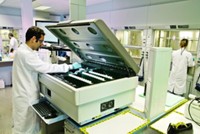Advertisement
Grab your lab coat. Let's get started
Welcome!
Welcome!
Create an account below to get 6 C&EN articles per month, receive newsletters and more - all free.
It seems this is your first time logging in online. Please enter the following information to continue.
As an ACS member you automatically get access to this site. All we need is few more details to create your reading experience.
Not you? Sign in with a different account.
Not you? Sign in with a different account.
ERROR 1
ERROR 1
ERROR 2
ERROR 2
ERROR 2
ERROR 2
ERROR 2
Password and Confirm password must match.
If you have an ACS member number, please enter it here so we can link this account to your membership. (optional)
ERROR 2
ACS values your privacy. By submitting your information, you are gaining access to C&EN and subscribing to our weekly newsletter. We use the information you provide to make your reading experience better, and we will never sell your data to third party members.
Business
Drugmakers Find A Fit For Contract Research
Big pharma and biotech firms continually evaluate the balance of in-house and outsourced assets
by Rick Mullin
June 22, 2015
| A version of this story appeared in
Volume 93, Issue 25
The contract research organization, or CRO, emerged as a distinct service option in pharmaceutical R&D just as the drug industry’s blockbuster era was winding down. The research budget and laboratory staff cutbacks that followed during the past 10 years created a market for R&D services in drug discovery, clinical trials, and chemical process development. CROs in the U.S., Europe, and Asia emerged to offer services in one or all of these areas.
But contract research services arose as more than just a support mechanism for downsizing at drug companies. Many small biotech firms depend entirely on contractors for research. And research managers at large drug and biotech firms say contract services have allowed them to focus in-house staff on emerging science while they shift workhorse chemistry outside. CROs have also allowed big firms to access expertise in new science from outside their own labs.
The net effect is that outsourcing is no longer an elective option but a permanent fixture in drug R&D at a time when research requirements, laboratory assets, and the management of scientific research are in flux. Interviews with research and process chemistry leaders at drug and biotech firms reveal a complex balancing act in which companies seek to achieve and maintain the right mix of in-house and outsourced services.
Merck Ramps Up USE Of R&D Services
Jos Brands is in charge of external process chemistry at Merck Research Laboratories. Having spent more than 20 years in Merck’s process chemistry department, Brands witnessed a rise in research outsourcing that led the company in 2012 to establish the executive-level position he now holds.

The process chemistry group’s primary responsibility is ensuring that all of the company’s research programs, ranging from early toxicity studies to clinical trials, are supplied with the bulk active pharmaceutical ingredients (APIs) they need. Secondly, it is tasked with delivering commercial manufacturing processes to the Food & Drug Administration for approval.
Over the past 10 years, Merck’s use of contractors in process development and chemical manufacturing gradually ramped up. But it wasn’t until Brands took his current position that the effort really crystallized.
“We had some people completely dedicated to working with CROs, but we didn’t have anyone representing them on the senior leadership team,” Brands says. “We’ve started sourcing at the level where there is such a massive amount of work and deliverables we bring back to the corporation that we thought the organization needed representation on senior leadership in process chemistry.”
Along with R&D outsourcing by Merck and other drug firms has come globalization. Not surprisingly, given the amount of manufacturing that has gone to the region, Asia has seen rapid growth in the research services sector. Brands, in fact, spends most of his time in Shanghai near WuXi PharmaTech, a top supplier of contract services to Merck and other firms.
WuXi is among the CROs that have attempted to amass a comprehensive offering—a one-stop shop for contract research. Although Brands and others managing contractors are skeptical that one supplier can establish itself as equally competent at all aspects of drug research, WuXi’s size and varied capabilities fit with Merck’s strategy of limiting the number of CROs it works with, according to Brands.
“In the past, we worked with many different CROs and found that a difficult model,” he says. “If you work with a lot of CROs, there is a lot of overhead.”
Along the way, Brands has discovered some truths about outsourcing. “There are two general models for outsourcing research,” he says. “One is to generate a technical package, a doable proposition, and to hand it over to a CRO and ask them to execute on it and perhaps generate a kilo or whatever.
“With the other model, which we adopted quite early, you do not solve problems internally first. You take the problem to the CRO and work with them shoulder-to-shoulder. That is why we have people on the ground in China.”
The primary benefit to this approach, Brands adds, is that it frees Merck from the routine aspects of process development to focus internal resources on “a more difficult set of problems” in process chemistry.
Brands leads a team of six chemists in China and the U.S. Although Merck has contracts with U.S. service firms, “the quality we get from Chinese CROs matches what we get from the U.S.,” he says.
Chinese services can be lower in cost, but Brands claims he doesn’t place great emphasis on cost savings. “What we get from WuXi is an enormous amount of flexibility,” he says. Because of the service firm’s size, it can move projects around and start and stop work quickly.
Although Merck, like most large drug companies, has downsized its research staff, it has not outsourced R&D reactively, Brands says. Rather, outsourcing is a strategy for research triage.
“When you come from the perspective of doing everything yourself, you basically need to staff yourself for peaks in demand,” he says. “But R&D in a major pharma company these days is such that you don’t always need the peak capacity.”
Beyond The Corporate Lab At Pfizer

At Pfizer, contract research services are a means to enhance efficiency, access research capabilities, and focus in-house research on key scientific problems, says Laurie Chipperfield, senior director of strategic sourcing. She describes an ongoing experiment in balancing in-house and external labs in Pfizer’s worldwide research network.
“It’s hard to get people globally under one management regimen,” Chipperfield says. “It’s all about how things pull together into one end product with this mix of internal and external research. We continue to be curious about what can happen in that space.”
Pfizer, like Merck, is open to contracting with Chinese service firms, despite the concerns some managers have about quality and rising costs. Regardless of contractor location, direct engagement is required, according to Chipperfield.
“We are collaborative in everything we are doing from manufacturing to development,” she says. “We have highly capable scientific staff internally that provide some guidance up front. The rarity is when we hand something off and wait for the materials. We have weekly teleconferences with the providers and scientific staff. That’s the routine way we do business.”
Pfizer’s new drug pipeline is evolving, Chipperfield says, and the company is on the lookout for external support in areas such as antibody-drug conjugates and high-potency APIs. “As our portfolio mix changes, we get into different technologies and expertise with our vendors,” she says.
Striving for Speed at Genentech
Francis Gosselin, director of process chemistry at Genentech, describes his purview as supporting the company’s small-molecule pipeline by developing processes and delivering APIs for clinical trials. “This is done through a combination of internal manufacturing and outsourcing,” he says.

Finding an ideal service firm is a struggle, Gosselin says, as is achieving the right balance between in-house and external resources. “It’s a matter of using our internal resources on the most challenging chemistry and on high-priority projects where you need to move fast,” he says.
Gosselin emphasizes speed as a prime consideration in selecting a service firm. Having a one-stop shop that can handle a job without needing to transfer technology to another service firm would be a definite advantage, he says. “But we are struggling to find a firm that can do the research fast, do the development fast, and do the manufacturing fast so that everything goes fast.”
Expertise varies regionally, Gosselin notes. “There are places in Europe with outstanding reputations in development and manufacturing, but they don’t necessarily move very fast,” he says. “China, in general, moves quite fast. But if you run into very sophisticated development problems, they lack a bit. India is not part of the equation other than for supplying starting materials.”
As for the U.S., “we are struggling to find shops that can do all these activities very well so that we are not five or more time zones away,” Gosselin says. On the other hand, he acknowledges that 24-hour-a-day operation is a benefit of spreading research out to Europe and Asia. And as CROs become larger and more diversified, research services in areas such as hazardous chemistry and final-dosage formulation become available.
“And I see more CROs coming up around catalysis and biocatalysis,” Gosselin says. “Not necessarily to the point of manufacturing. But in terms of research? Yes.”
Holding on to Science at Amgen

At Amgen, outsourcing has ramped up rapidly since 2010, when the firm was still doing all research and small-scale manufacturing in-house, according to Matthew Bio, director of process development. “Since then, we have been building up a network of suppliers for our early-phase pipeline. We started with outsourcing API starting materials, but since 2012, we have been outsourcing cGMP intermediates,” he says, describing intermediates made in keeping with FDA’s current Good Manufacturing Practices standards.
Outsourcing advanced partly as a means of reining in R&D spending, Bio says. But it was also driven by advances in the company’s research pipeline. “We got to the point where we would have had to hire a lot more people or find a way to do our work differently,” he says. “The decision was to develop a network of suppliers.”
Process development is still done internally, other than for a handful of specialized chemistries such as crystallization and enzymatic catalysis.
Amgen wants to go further, but the path is rocky. “We’re looking at the cost-benefit of doing the entire first delivery up to the drug substance externally,” Bio says. “We have played around with that, done case studies and one-off experiments.” It’s not yet clear whether the approach is feasible.
One challenge is keeping the number of suppliers to a minimum. Currently, Amgen contracts with Syngene in India, Norchim in France, and Sigma-Aldrich and Hovione in the U.S. Suppliers tend to work with the company at different stages of drug development.
Bio agrees with others about the unlikely prospect of finding the perfect one-stop supplier. “I think there is a lot of interest in doing that from the business side of the house,” he says. But the complexity of pharmaceutical research is such that any one supplier is rarely good at everything.
As Amgen moves forward, so does the CRO sector. Bio agrees with his peers that the trend toward outsourcing research is irreversible.
“And that’s the great fear,” he says. “There are cases now where nobody internally has experience scaling up a chemistry that all of a sudden needs to move rapidly. The real danger is in the young staff who, in some places, have never done any scale-up work themselves.”
Outsourcing, he says, can cut scientists off from critical training. “You see a real disconnect between the understanding of how things run in a plant versus the process development.”
Amgen guards against this, according to Bio, by requiring chemists to be in the plant for the running of processes, even if confidence is high that they will be problem-free. “It might be their only opportunity to experience the impact of scale-up on their chemistries,” he says. “What I worry about is that there will be a generation of pharmaceutical company chemists with no internal manufacturing experience.”
The concern needs to be addressed, given that even greater levels of contract research are inevitable, Bio says.
“We are trying to maintain a connection to manufacturing but take out all the overhead associated with internal manufacture,” he says. “When somebody says we are going to outsource a program, there is still a huge staffing requirement. There are going to be people on the ground to oversee the day-to-day development of the chemistry and actually bring in some of the more complicated things that may hang a vendor up.”
The company doing the outsourcing, Bio notes, may find itself in the paradoxical situation of compensating for a lack of resources at its service firm.
Elevating Chemistry at Novartis
Drug company research executives are also surveying an R&D landscape that now features the CRO as a permanent structure.
“There is no question that the industry as a whole is making increased use of extramural contractors for certain kinds of work, and Novartis is doing so,” says Don Ganem, head of infectious disease research at the Swiss drugmaker. “I think other companies have taken this to more of an extreme than we have, but it’s fair to say that across the industry this is a trend. It reflects the globalization of the economy and of certain skills.”
Advertisement
Ganem, who is based at the Novartis Institutes for BioMedical Research in Emeryville, Calif., sees routine chemistry—aspects of pharmacokinetics, for example—that are candidates for outsourcing. The company, like most other major drug firms, also outsources chemistry for molecular synthesis. But Ganem sees limits to what can be done externally.
“There are those who feel you can have all medicinal chemistry done that way. I think that is misguided,” he argues. “One of the problems with outsourcing chemistry is that it can lead to a mind-set among some managers that chemistry is a commodity. Chemistry is not a commodity. It is a science. I am a strong believer in the value of chemical intuition and insight. Some of the most important conversations I have are with our structural and computational chemists.”
Ganem acknowledges the cost-benefit of robust outsourcing, “but one cannot think that because certain synthetic services are available at reduced cost externally that that is a substitute for resident expertise. It is not.”
Geographic location is not as important as contractor specialization in selecting a research service provider, in Ganem’s view. “What is important is to recognize there are firms with specialty expertise worth tapping into—nucleoside chemistry, β-lactam chemistry. If you go to a generic services provider, you won’t get the same level of service in those niches. It takes some time and some experience to find out who they are.”
Although Novartis has not made sweeping reductions in research staff, outsourcing has allowed the firm to limit growth in R&D spending, Ganem says. “There is no question that we are seeking a balance between high-level talent internal to the company and the outsourcing of the more routine aspects of the organization,” he says.
Rather than diminishing chemistry, Ganem and others suggest that achieving a balance between in-house and contract research may have the effect of actually elevating the science in corporate labs. Ideally, the practice of outsourcing will also keep R&D organizations flexible in adapting to new technology in drug discovery.
“I would go so far as to say it has changed our internal R&D,” Merck’s Brands says. “We are now able to focus on what we consider to be the toughest problems, and we’re still able to attract top-notch chemists who thrive on taking on the most difficult challenges.”





Join the conversation
Contact the reporter
Submit a Letter to the Editor for publication
Engage with us on Twitter